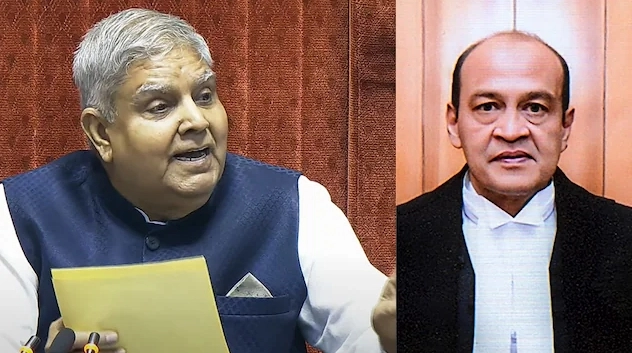
The allegations of cash recovery from Delhi High Court’s judge Justice Yashwant Varma’s residence has rekindled the debate on the National Judicial Appointments Commission (NJAC) Act, which was passed by Parliament in 2014, but was struck down by the Supreme Court in 2015.
Vice-President Jagdeep Dhankhar while addressing the Rajya Sabha on Tuesday said he was “bothered by the incident", and referred to the NJAC Act, which was meant to replace the collegium system.
“It is not as if executive, judiciary and legislature are pitted against each other," Dhankhar remarked.
Dhankhar also held a meeting with floor leaders of parties to discuss the issue. His remarks came on the day a three-member committee was formed by the Supreme Court to inquire into the conduct of Justice Varma.
The committee, comprising Chief Justice of Punjab and Haryana High Court Justice Sheel Nagu, Chief Justice of Himachal Pradesh High Court Justice GS Sandhawalia, and Justice Anu Sivaraman of Karnataka High Court, reached Justice Varma’s Tughlak Crescent bungalow at around 1.30 pm on Tuesday and left after nearly 45 minutes.
Collegium is the system of appointment of Judges of the higher judiciary, which evolved through a series of Supreme Court judgments known as “Judges Cases."
The Central government has been criticising the opaque nature of the collegium system behind a large number of judicial vacancies.
The NDA government in 2003 introduced the Constitution (98th Amendment) Bill in the Lok Sabha for the formation of the National Judicial Commission (NJC). The NJC would be chaired by the CJI, with two of the senior-most judges of the Supreme Court as its members. The Union law minister would be a member, along with an eminent citizen to be nominated by the President in consultation with the Prime Minister. The NJC would decide the appointment and transfer of judges and probe cases of misconduct by judges, including those from the highest judiciary.
Thus, in 2014, the NDA government introduced the National Judicial Appointments Commission (NJAC) Act to provide the executive branch a significant role in selecting judges for the higher courts.
The NJAC Bill and the Constitutional Amendment Bill were ratified by 16 Indian state legislatures before being signed by President Pranab Mukherjee on December 31, 2014. The NJAC Act and the Constitutional Amendment Act went into effect on April 13, 2015.
But the Supreme Court had in 2015 struck down the JAC Act and the Constitution (99th Amendment) Act, 2014, leading to the revival of the collegium system of existing judges appointing judges to constitutional courts.
The bench, headed by the then CJI J S Khehar, asserted: "In the matter of appointment of judges to the higher judiciary, as also in the matter of their transfer, the primacy in the decision-making process inevitably rests with the Chief Justice of India."
The collegium system, headed by a chief justice, decides the appointment and transfer of judges. The forum consists of four senior-most Supreme Court judges as well.
The collegium decides the elevation of Chief Justices/Judges of High Court to the Supreme Court, judges of High Courts as Chief Justices and other judges. In case of a difference of opinion, the majority view will prevail.
A High Court collegium consists of two judges with the next two highest ranks. This collegium suggests candidates for the High Court positions. A collegium of the Chief Justice and the Supreme Court’s two senior-most judges takes the final call.
The Supreme Court had recently agreed to hear a petition against the collegium. The petition sought a new mechanism for the appointment. The matter was mentioned by Advocate Mathews J Nedumpara before a Bench comprising former CJI Chandrachud, Justice Hima Kohli and Justice JB Pardiwala.
In the plea, Nedumpara and others asked the court to declare collegium synonym for nepotism and favoritism, as it has resulted in “the denial of fair opportunity in the selection and appointment of judges".
Article 124 mentions that the appointment of Supreme Court judges should be made by the President after consultation with such judges of the High Courts and the Supreme Court as the President may deem necessary. The CJI is to be consulted in all appointments, except his or her own.
Article 217 deals with the appointment of High Court judges. It says a judge should be appointed by the President after consultation with the CJI and the Governor of the state. The Chief Justice of the High Court concerned too should be consulted.
The collegium system has its genesis in a series of three judgments, which have been clubbed as the ‘Three Judges Cases’. Following the SP Gupta case on December 30, 1981, popularly known as the ‘First Judges Case’, it was recommended that the executive branch should have the most influence over judicial nominations.
Twelve years later, in 1993, in the ‘Second Judges case’, a nine-judge court ruled that the CJI must be given preference in such appointments.
In 1998, President KR Narayanan issued a presidential reference to the Supreme Court as to what the term “consultation" really means in Articles 124, 217 and 222 (transfer of HC judges) of the Constitution. The question was if the term “consultation" requires consulting a number of judges in forming the CJI’s opinion, or whether the sole opinion of the CJI constituted the meaning of the articles. In reply, the Supreme Court laid down nine guidelines for the functioning of the coram for appointments/transfers; this came to be the present form of the collegium.
Besides, the ‘Third Judges Case’ judgment dated October 28, 1998, written by Justice SP Bharucha as the head of the nine-judge bench, strongly reinforced the concept of a ‘primacy’ of the highest judiciary over the executive.